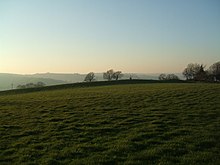Cranmore Castle
As Cranmore Castle be earthworks from the iron time on a slope above Tiverton in the English county Devon designated. They are considered a Scheduled Monument .
The earthworks are generally in leaders and stories as Iron Age hill fort described when younger archaeological work as that of Mike Sampson represent that the place as a fortress must have been ineffective because he in the south of the higher Exeter Hill and Newtes Hill surmounted. For a fortress, it would also be unusual for the enclosure to enclose a slope of 120–170 meters above sea level. However, the site has good views of Cadbury Castle , Castle Close below Stoodleigh up the Exe Valley, Huntsham Castle , Hembury Fort and other important mounds and earthworks, which suggests that they are all contemporary. From Cranmore Castle you can also see the confluence of the River Lowman with the River Exe and the fords over the two rivers, which would not be possible from a higher location.
The hillside location over which Cranmore Castle stands is mentioned in several stories from the area Skrink Hills (or Shrink Hills ). From there, Thomas Fairfax's artillery besieged Tiverton Castle in the English Civil War . The headland connecting Cranmore Castle to the edge of Newtes Hill is crossed by the old Exeter Road , which runs over the earthworks on its way from Tiverton to Exeter . The hill and road have recently been called Exeter Hill , and the road almost certainly follows the route of a prehistoric trail.
Current theories about the nature of the earthworks are that they are mistaken for a winter pasture for livestock or a marketplace, even if the earthworks would be very high for such use and could also indicate a tribal oppidum . The fenced-in area would certainly be large enough for this. The Ordnance Survey map for southern Britain in the Iron Age shows Cranmore Castle as the largest enclosure in Devon (along with Hillsborough ) with an area of 6.1 hectares.
During the Prayer Book Rebellion in 1549, a cruel battle took place at Cranmore Castle, in which both sides argued over whether a child should be baptized according to the "new" or the "old" religion. The battle took place near a small chapel that stood in a corner of the compound near the road. The chapel was demolished in the 17th century and in 1687 bones and musket ammunition believed to be the remains of the battle were found.
The etymology of the name "Cranmore Castle" is not clear. Cranmore is not a local name, nor does it resemble a local place name. He is also not mentioned in early sources. It is possible that it was derived from the battle described above. The Archbishop of Canterbury at the time of the Prayer Book Rebellion was Thomas Cranmer , and so it is possible that the current name is a corruption of "Cranmer Castle" to commemorate the battle fought there.
Web links
Individual evidence
- ^ A b R. R. Sellman: Aspects of Devon History . Devon Books, 1985. ISBN 0-86114-756-1 . P. 11 (map).
- ^ Mike Sampson: History of Tiverton . 2004. ISBN 0-9548788-0-9 .
- ^ Martin Dunsford: Historical Memoirs of Tiverton . Brice, Exeter 1790.
- ↑ Lt. Col. Harding FGS: The History of Tiverton, In the County of Devon . Boyce, Whittaker 1845.
- ^ Map of Southern Britain in the Iron Age . Ordnance Survey, 1962.
- ^ Martin Dunsford: Historical Memoirs of Tiverton . Brice, Exeter 1790. p. 197.
Coordinates: 50 ° 53 ′ 45.6 " N , 3 ° 28 ′ 55.2" W.
